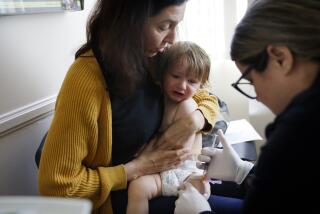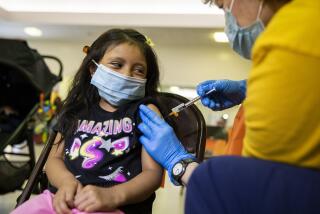Valley Vaccination Campaign Launched : Health: More than 250 free clinics will open. Business coalition hopes to improve L.A. County’s low immunization rate.
- Share via
Saying children in Los Angeles County have one of the lowest vaccination rates in the nation, a business coalition on Tuesday launched what it described as the largest private sector immunization drive ever undertaken in California.
The group said it hopes to boost the county’s 40% vaccination rate--the worst of California’s most populous counties--by sponsoring more than 250 free clinics in the San Fernando Valley.
The move was applauded by county health officials still haunted by a measles epidemic that killed 40 children and left another 2,700 hospitalized between 1987 and 1991. Some child-health experts predict another outbreak will strike in a year or two.
Los Angeles County’s vaccination rate is significantly below both the statewide and national rates--48.5% and 55.3% respectively--for 2-year-olds who are fully immunized against measles, polio, mumps, rubella, diphtheria and other childhood diseases.
Health authorities blame the county’s poor ranking on several factors, including its large population of toddlers, many immigrant parents who do not understand English, a limited number of public health clinics and soaring vaccine prices.
Also, experts say, many 30- to 40-year-old parents--who only had to wince their way through about four shots when they were young--are unaware of how many shots must be administered these days for complete immunization. Some of the vaccines used today didn’t exist before the mid-1960s.
“Parents have this image of kids lining up at school for polio shots. They don’t realize it takes 16 to 18 doses of vaccine,” said Joseph Liu, director of policy for Children Now, an advocacy group. “It’s a lot more complicated than people remember.”
Immunization rates are particularly low among the county’s poor, who often cannot afford to take time off from work for repeated visits to the doctor or cannot reach public clinics scattered over such a vast region for free shots. And many illegal immigrants, fearing exposure, are wary of taking their children to government clinics at all, experts say.
In addition, the cost of full vaccination has skyrocketed in recent years. Shots that cost less than $11 in the mid-1970s now are priced at more than $235, not including any charges to administer them, according to the Children’s Defense Fund.
Backers of the private inoculation effort said they are not trying to take over from the County Health Department but merely supplement its efforts.
“The county has done a fantastic job trying to reach these people, but they just don’t have the resources,” said Greg Waskul, a spokesman for Burbank-based UniHealth America, which operates hospitals in the Valley and is spearheading the drive, called Operation Immunization.
To kick off the effort, nurses gave free shots at a Northridge elementary school Tuesday, trying to stick needles as gently as possible into small children who promptly began screaming.
“I took Tylenol even before I came over,” said Judee Stelly, a nurse who normally works in the emergency room at nearby Northridge Hospital Medical Center.
Jess Ross of La Crescenta said he came to the school to take advantage of the free injections for his 20-month-old daughter, Mychelle.
“They run about $160 when you go to a private clinic,” he said, adding that he has no health insurance.
Waskul said Operation Immunization will hold more than 250 clinics in the Valley over the next six months at elementary schools, McDonald’s restaurants and the Volunteer Center in Van Nuys. Vaccines will be provided by the county.
In addition, the organization plans a massive education campaign to inform parents of the potentially fatal consequences of not vaccinating their children. It hopes to enlist hundreds of local businesses, churches, synagogues and community groups to help disseminate brochures and sponsor lectures.
An ongoing education campaign is crucial because it doesn’t matter how many parents make sure their children get shots today if the next crop of parents don’t do the same for their children, Waskul said.
“Our purpose is to inoculate the minds of parents,” he said.
Waskul said Operation Immunization has signed a contract with the Los Angeles Unified School District to run weekly clinics at seven schools and to eventually expand throughout the district.
He said many immigrants seemingly are less wary of schools than of government health clinics, and most can easily walk their children to a neighborhood school.
Dr. Shirley Fannin, the county’s chief of communicable disease control, said the government was happy to get help from private business.
She said the county’s low vaccination rate is partly attributable to its thorough reporting, but conceded that it ranks poorly compared to other large urban areas.
On a statewide level, although only 48.5% of 2-year-olds are fully inoculated, the rate varies considerably among ethnic groups.
Anglos have the highest rate--58%--followed closely by Asians at 56%, according to the California Department of Health Services. Forty-four percent of African Americans and 37% of Hispanics are fully immunized, but only 22% of Southeast Asians are.
Waskul said poor vaccination should not be viewed as a problem only of low-income people and minorities, however. It cuts across all races and economic classes, he said, and some countries enjoy a far higher rate than California’s.
Mexico, for instance, vaccinates a whopping 96% of its 2-year-olds, he said.
In 1990, amid a nationwide measles epidemic, the federal Centers for Disease Control recorded more than 27,000 confirmed cases of measles, almost half of them in California.
Liu of Children Now said that due to Los Angeles County’s low immunization rate, measles remains “essentially endemic--it’s always there.”
He said because so few toddlers are properly vaccinated, and because the disease often runs on a three- or four-year cycle, many health experts expect “a new resurgence in the next year or two.”
Vaccination Schedule
The following table shows the immunization schedule recommended for children by the federal Centers for Disease Control and Prevention. It shows all the vaccinations that a child should receive from birth to 16th birthday.
Months Vaccine 2 4 6 12-15 15 4-6 DTP X X X X (b) X Polio X X X (c) X Measles, mumps and rubella (MMR) X X (d) Meningitis X X X (e) X Tetanus
Years Vaccine 14-16 (a) DTP Polio Measles, mumps and rubella (MMR) Meningitis Tetanus X
birth 1-2 mos. 4 mos. 6-18 mos. Hepatitis B X X X or X X X
(a) And every 10 years thereafter.
(b) This dose of DTP can be given as early as 12 months, at the same visit as measles, mumps and rubella and meningitis vaccines, as long as it has been at least six months since the previous DTP dose. Some experts recommend this dose at 18 months.
(c) Some experts recommend this dose between 6 and 18 months.
(d) Some experts prefer to give this dose of measles, mumps and rubella vaccine at entry to middle or junior high school.
(e) This dose may not be required, depending on which meningitis vaccine is used.
More to Read
Sign up for Essential California
The most important California stories and recommendations in your inbox every morning.
You may occasionally receive promotional content from the Los Angeles Times.










